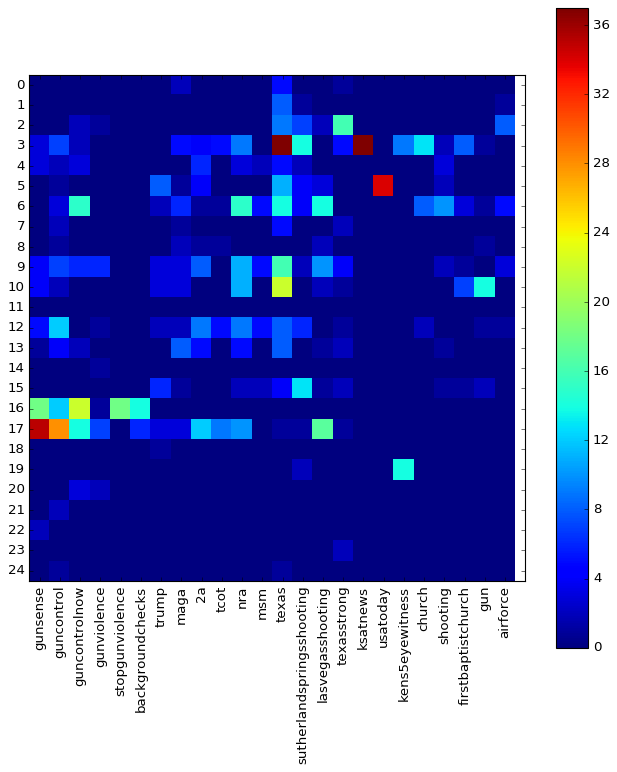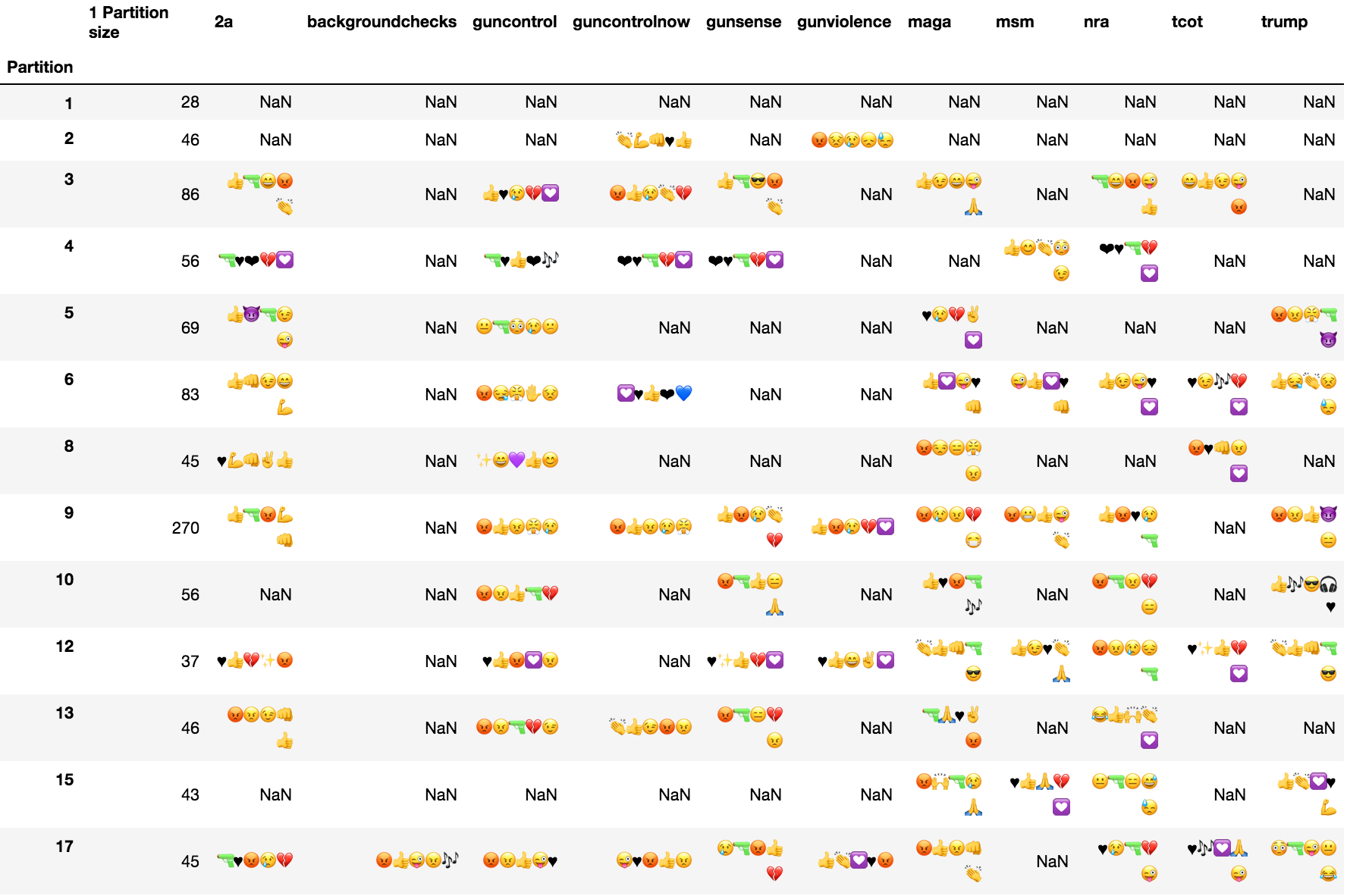Community Analysis
#texasshooting
The next step in our analysis is to define communities in our network and see what these communities revolve around.First, we will look into the sizes of the communities and the biggest accounts in the biggest communities, to get a sense for the kind of accounts we find. Then, we will look into the most common hashtags used in every community in the mention graph, to get a feeling for the topics that live in every community.
We use the Louvain method [1] for community detection with the following implementation in Python.
Plots
Below two plots are displayed of the communities found with the Louvain algorithm, with a legend table that shows some info on the most connected node in this community, under the assumption that this will tell us something about the community as a whole.
| Partition | Size | Top Account | Location | URL | Degree | Followers |
|---|
Analysis
We can see that for the mention graph, the communities have for the biggest part centred themselves around major news outlets. We see @FoxNews and @ABCNews, but also local news stations as @dallasnews and their reporters, like @lmcgaughy. For the hashtag graph, seem a bit more random. We do, however recognize the twitter accounts of Sputnik News, a Russion state controlled media outlet, linked to fake news on multiple occasions, and marypatriotnews.com which is a hyper conservative outlet to say the least.
It is interesting
to see that the highest degree nodes in the hashtag_graph’s partitions are
not necessarily
accounts with many followers. The links in this network are much more
‘democratic’, where anyone who uses a lot of prevalent hashtags can becomes
a well connected node in the graph. This is different from the mention_graph
where a user only gets mentioned a lot if he is well known and thus likely
to have many followers.
Hashtag Heatmap
To drill down further on what plays in the communities found in either network, we will look at the hashtags are used in these communities and how they relate to each other. A heatmap shows the number of occurrences of the top hashtags in each community. The brighter the color, the more prevalent that hashtag is in the tweets from that community and by extension from the users. This gives us an idea about the ideas or opinions of these users. The data is a little sparse for some communities since they are small and there are not that many hashtags, but we can see some interesting patterns emerge in the ones that do have data.
Mention Graph
We have communities 16 and 17 mentioning #guncontrol, #gunsense, #guncontrolnow, #gunviolence and #stopgunviolence, which are all hashtags related to the camp that wants to limit guns in America. Partitions 3 and 5 and 19 mention in #texas combination with news outlets #kens5eyewitness, #ksatnews and #usatoday, seemingly neutral. There are a bunch of more republican oriented hashtags floating around, #trump, #maga (Make America Great Again), #2a (2nd amendment which protects gun owners), #tcot (top conservatives on twitter), #msm (mainstream media) and #nra (national rifle association - lobby group for gun carry rights), which seem a little more used by the partitions 12, 13, 9, 10, 5 and 6.

Hashtag Graph
This heatmap is bit sparser, but some interesting things can be found still. Partition 0 has high occurences of the hashtags #guncontrol, but in combination with #trump, #2a and #nra, which are all very much pro gun carrying. This could mean the hashtag is used within a whole different context, where the people in this community talk about gun control in a negative sense. Also, they talk about #mentalhealth, which could be a way to divert to a conversation where guns are not the problem, but mental health. The other communities that display noticable correlation seem to follow similar patterns or have very neutral hashtags.

Emoji Hashtag Matrix
As we can see above, the use of a hashtag can be fairly ambiguous. People can use a certain hashtag and be either pro or against it, or use the hastag in a sarcastic or ironic way. To add a bit more context we thought it would be interesting to look at what sentiments or thoughts are associated with the hashtags in each community. For this, we used DeepMoji [2] again. These researchers from MIT, among other universities, have constructed a way to train neural networks on text with emojis that let them predict a series of emojis from a sentence. The project is freely available on github including the pretrained models, which can quite articulately describe the sentiment or feeling of that piece of text. We decided to correlate the hashtags used in every community with the emojis returned from DeepMoji to get a more refined image of the opinions that are prevalent in these communities.
Below, the results of this correlation are displayed in a emoji / hashtag matrix for the communities. De rows represent the different communities in the networks and the columns the most common hashtags in these networks. In the cells the most common emojis found through DeepMoji prediction are displayed. The smallest communities and some trivial hashtags have been left out for clarity.
Mention Graph

From the table above, it is clear that some communities have more unified feelings about certain topics than others. Most homogenic would be community 6, which has either negative or positive emojis for most hashtags. They are big fans of #2a (second amendment) but not so much of #guncontrol. They display rather positive emotions for #maga (make america great again), #msm (mainstram media, but used by far right), #nra (the national rifle association) and #tcot (top conservative on twitter). They seem rather divided on #trump with both clapping and crying emojis. Interesting to see that the most connected users in this community are ABC News and CBS News.
Similar emojis appear for community 9, except that an angry emoji appears alongside all other ones. Maybe the language used in this community has a lot of anger in it. Community 2 seems to condone #gunviolence and in favor of #guncontrolnow.
Hashtag Graph
Unfortunately, the emoji / hashtag matrix for the hashtag graph is very incoherent. All cells with emojis seem to express contradicting feelings. It is included for completeness. The hashtag network’s communities are small and there was less data for this event in the data base to find the hashtags from.

Conclusion
Overall, we have found some interesting results from the community analysis on
both networks, but for the mention_graph it was definitely more insightful than
for the hashtag_graph. Since the partition is based of modularity of the
separate communities, it makes sense that a more ‘hierarchical’ and well defined
like the hashtag_graph. This showed in terms of the type of users made up the
big nodes in the network, as well as the more coherent partitions found in the
mention_graph.
A big probelm with comminity detection is the validation of the communities, especially if they get large. The hahstag emoji matrix seems to be an interesting tool to do this. However, we see that many communities have mixed emojis per hashtag. This could point to divided communities but could also be a result of data sparsity, inaccuracy of the model or the fairly simple way the emojis were counted and averaged out. More than a definite end result, this matrix should be seen as a proof of concept which should be perfected to give accurate results.